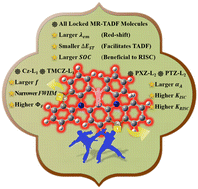Multi-resonance thermally activated delayed fluorescence molecules with intramolecular-lock: theoretical design and performance prediction†
Abstract
Multi-resonance thermally activated delayed fluorescence (MR-TADF) molecules with narrow full width at half maximum (FWHM) have attracted much attention recently. In this work, 36 borane/amine (B/N) type MR-TADF molecules were theoretically designed by using an intramolecular-lock strategy and systematically studied based on first-principles calculations. It was found that intramolecular-lock at different positions and in different manners could induce different luminescent properties. The calculated oscillator strengths for PXZ-L2 and PTZ-L2 locking systems are weaker than that for 2DPABN (without intramolecular-lock), while the Cz-L1 and TMCZ-L1 locking could result in stronger oscillator strength. Though the calculated FWHM of all the systems with intramolecular-lock is higher than that of 2DPABN, the Cz, TMCz and DMAC locking at L1 or L2 would induce relatively small FWHM which is comparable to that of 2DPABN. Our calculation results indicate that intramolecular-lock could enhance the SOC values and decrease the energy gap between the first singlet excited state and the first triplet excited state, which is quite favorable to reverse intersystem crossing. The Cz, TMCz and DMAC locking systems could realize comparable and higher efficiency than 2DPABN, thus higher quantum efficiency could be obtained. Our calculation results indicate that the intramolecular-lock strategy is an effective method to realize the design of highly efficient MR-TADF emitters.



 Please wait while we load your content...
Please wait while we load your content...